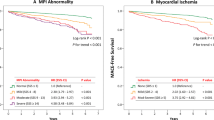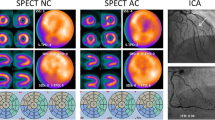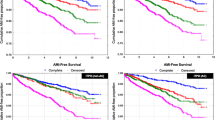Abstract
Background
Current guidelines of Food and Drug Administration for the evaluation of SPECT myocardial perfusion imaging (MPI) in clinical trials recommend independent visual interpretation by multiple experts. Few studies have addressed whether quantitative SPECT MPI assessment would be more reproducible for this application.
Methods and Results
We studied 31 patients (age 68 ± 13, 25 male) with abnormal stress MPI who underwent repeat exercise (n = 11) or adenosine (n = 20) MPI within 9-22 months (mean 14.9 ± 3.8 months) and had no interval revascularization or myocardial infarction and no change in symptoms, stress type, rest or stress ECG, or clinical response to stress on the second study. Visual interpretation per FDA Guidance used 17-segment, 5-point scoring by two independent expert readers with overread of discordance by a third expert, and percent myocardium abnormal was derived from normalized summed scores. The quantitative magnitude of perfusion abnormality was assessed by the total perfusion deficit (TPD), expressing stress, rest, and ischemic perfusion abnormality. High linear correlations were observed between visual and quantitative size of stress, rest, and ischemic defects (R = 0.94, 0.92, 0.84). Correlations of two tests were higher by quantitative than by visual methods for stress (R = 0.97 vs R = 0.91, P = 0.03) and rest defects (R = 0.94 vs R = 0.82, P = 0.03), respectively, and statistically similar for ischemic defects (R = 0.84 vs R = 0.70, P = ns).
Conclusions
In stable patients having serial SPECT MPI, quantification is more reproducible than visual for magnitude of perfusion abnormality, suggesting its superiority for use in randomized clinical trials and monitoring the effects of therapy in an individual patient.







Similar content being viewed by others
References
Mahmarian JJ, Shaw LJ, Filipchuk NG, et al. A multinational study to establish the value of early adenosine technetium-99m sestamibi myocardial perfusion imaging in identifying a low-risk group for early hospital discharge after acute myocardial infarction. J Am Coll Cardiol 2006;48:2448-57.
Shaw LJ, Berman DS, Maron DJ, et al. Optimal medical therapy with or without percutaneous coronary intervention to reduce ischemic burden: Results from the Clinical Outcomes Utilizing Revascularization and Aggressive Drug Evaluation (COURAGE) trial nuclear substudy. Circulation 2008;117:1283-91.
Dangas G, Stone GW, Weinberg MD, et al. Contemporary outcomes of rescue percutaneous coronary intervention for acute myocardial infarction: Comparison with primary angioplasty and the role of distal protection devices (EMERALD trial). Am Heart J 2008;155:1090-6.
Schwartz RG, Pearson TA, Kalaria VG, et al. Prospective serial evaluation of myocardial perfusion and lipids during the first six months of pravastatin therapy: Coronary artery disease regression single photon emission computed tomography monitoring trial. J Am Coll Cardiol 2003;42:600-10.
U.S. Department of Health and Human Services, FDA. Guidance for industry developing medical imaging drug and biological products. Part 3: Design, analysis, and interpretation of clinical studies. http://www.fda.gov/cber/gdlns/medimagestud.htm, June 2004.
Mahmarian JJ, Moye LA, Verani MS, Bloom MF, Pratt CM. High reproducibility of myocardial perfusion defects in patients undergoing serial exercise thallium-201 tomography. Am J Cardiol 1995;75:1116-9.
Wackers FJ. Science, art, and artifacts: How important is quantification for the practicing physician interpreting myocardial perfusion studies? J Nucl Cardiol 1994;1:S109-17.
Berman DS, Germano G. Interpretation and reporting of gated myocardial perfusion SPECT. In: Germano G, Berman DS, editors. Clinical gated cardiac SPECT. 2nd ed. Oxford, UK: Blackwell Publishing; 2006. p. 139-71.
Abidov A, Bax JJ, Hayes SW, et al. Integration of automatically measured transient ischemic dilation ratio into interpretation of adenosine stress myocardial perfusion SPECT for detection of severe and extensive CAD. J Nuc Med 2004;45:1999-2007.
Hachamovitch R, Hayes SW, Friedman JD, Cohen I, Berman DS. Comparison of the short-term survival benefit associated with revascularization compared with medical therapy in patients with no prior coronary artery disease undergoing stress myocardial perfusion single photon emission computed tomography. Circulation 2003;107:2900-7.
Germano G, Kavanagh PB, Su HT, et al. Automatic reorientation of three-dimensional, transaxial myocardial perfusion SPECT images [see comments]. J Nucl Med 1995;36:1107-14.
Mazzanti M, Germano G, Kiat H, et al. Identification of severe and extensive coronary artery disease by automatic measurement of transient ischemic dilation of the left ventricle in dual-isotope myocardial perfusion SPECT. J Am Coll Cardiol 1996;27:1612-20.
Bland JM, Altman DG. Statistical methods for assessing agreement between two methods of clinical measurement. Lancet 1986;1:307-10.
Slomka PJ, Nishina H, Berman DS, et al. Automated quantification of myocardial perfusion SPECT using simplified normal limits. J Nucl Cardiol 2005;12:66-77.
Prigent FM, Berman DS, Elashoff J, et al. Reproducibility of stress redistribution thallium-201 SPECT quantitative indexes of hypoperfused myocardium secondary to coronary artery disease. Am J Cardiol 1992;70:1255-63.
Bland JM, Altman DG. Applying the right statistics: Analyses of measurement studies. Ultrasound Obstet Gynecol 2003;22:85-93.
Danias PG, Ahlberg AW, Travin MI, et al. Visual assessment of left ventricular perfusion and function with electrocardiography-gated SPECT has high intraobserver and interobserver reproducibility among experienced nuclear cardiologists and cardiology trainees. J Nucl Cardiol 2002;9:263-70.
Cerqueira MD, Nguyen P, Staehr P, Underwood R, Iskandrian AE. Effects of age, gender, obesity, and diabetes on the efficacy and safety of the selective A2A agonist regadenoson versus adenosine in myocardial perfusion imaging. J Am Coll Cardiol Img 2008;1:307-16.
Bellenger NG, Davies LC, Francis JM, Coats AJ, Pennell DJ. Reduction in sample size for studies of remodeling in heart failure by the use of cardiovascular magnetic resonance. J Cardiovasc Magn Reson 2000;2:271-8.
Slomka PJ, Nishina H, Berman DS, et al. Automatic quantification of myocardial perfusion stress-rest change: A new measure of ischemia. J Nucl Med 2004;45:183–91.
Acknowledgments
This work was supported in part by grants from Bristol-Meyers-Squibb Medical Imaging, Inc. Billerica, Massachusetts, and Astellas Healthcare, Inc. Deerfield, Illinois. This research was supported in part by R01HL089765-01 from the NHLBI/NIH (PI: Piotr Slomka). Its contents are solely the responsibility of the authors and do not necessarily represent the official views of the NHLBI.
Author information
Authors and Affiliations
Corresponding author
Additional information
See related editorial, doi:10.1007/s12350-008-9020-6
This study was presented in part at the Society of Nuclear Medicine 55th Annual Meeting, New Orleans, Louisiana, June 14-18, 2008.
Rights and permissions
About this article
Cite this article
Berman, D.S., Kang, X., Gransar, H. et al. Quantitative assessment of myocardial perfusion abnormality on SPECT myocardial perfusion imaging is more reproducible than expert visual analysis. J. Nucl. Cardiol. 16, 45–53 (2009). https://doi.org/10.1007/s12350-008-9018-0
Received:
Revised:
Accepted:
Published:
Issue Date:
DOI: https://doi.org/10.1007/s12350-008-9018-0




